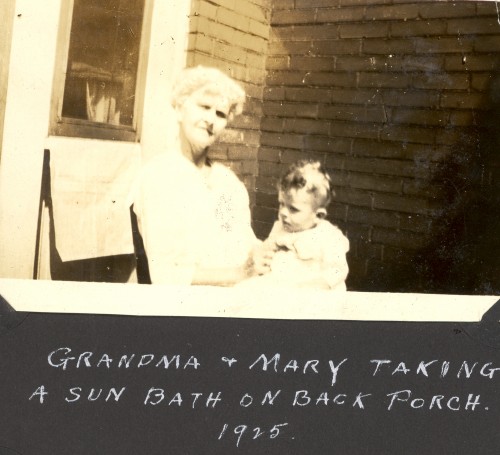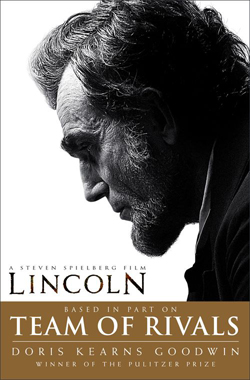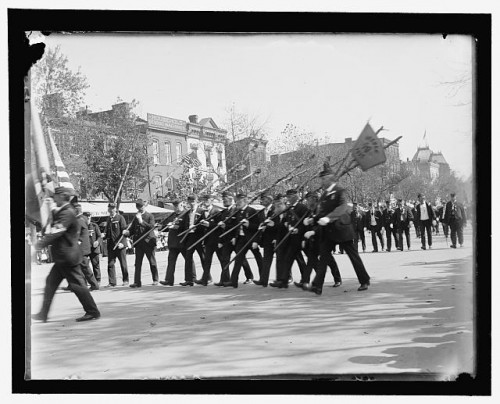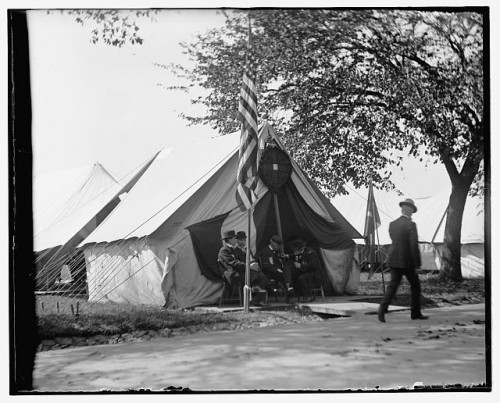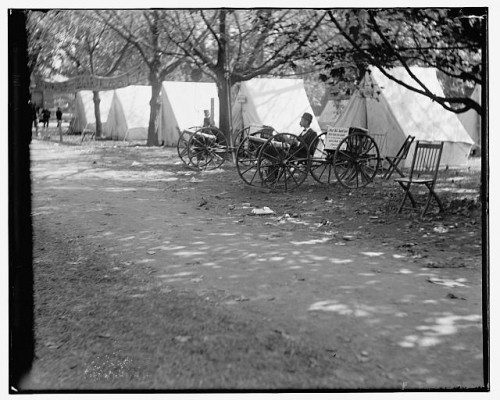Shopping Saturday: Abram Springsteen and His Civil War Drum, Part 1
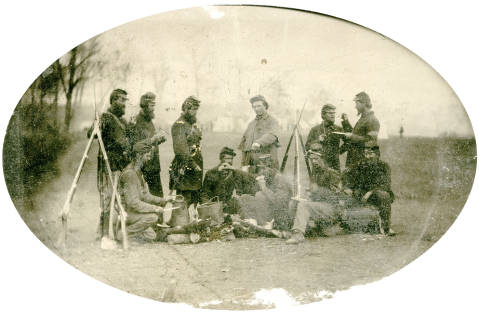
Helbling Family, Springsteen Family (Click for Family Tree)
What is generally called ‘shopping’ became ‘foraging’ of the hunter-gatherer style once a man became a soldier. This was true for Abram F. Springsteen as well. Mary T. (Helbling) McMurray, his great-niece, told her descendants the story she had been told about his foraging. Since he was so little at about age 12, Abram could get in and out of little places easily, like through a broken fence, board, or hole and into a barn or chicken house. He used to hide eggs inside his drum as he departed, and calmly leave the area with ‘only’ his drum. Abram’s comrades were always happy to see that their enterprising young comrade was out looking for a tasty supplement to the generally awful Army grub.
This is one of the many family stories that rings true. Abram included some of his ‘shopping’ escapades in his diary. He did not specifically note the ‘appropriation’ of eggs by the Union Army from the Confederates (or even Union sympathizers), but that most likely happened as well.
Abram’s diary describes a cold January ‘shopping’ trip with fellow soldiers:
“On the 17th we joined in the pursuit of Hood’s, going as far as Clifton on the Tenn river where we remained until the 16th of Jany 1865. During which time our rations ran out and one morning after reveille I proposed to one of the drummers by the name of John Ellis, that we start out on a foraging expedition. He being much older than I, we started after providing ourselves with a musket and some cartridges. After going about a mile from camp, we saw a house across a field from which we made a break but before reaching it we heard some firing to our left and upon looking around saw three men coming along a lane near by one of which was leading a mule and supposing them to be rebels, we hid behind a stone fence until they came out of the lane when we recognized them as being Yanks. Upon seeing us, they called to us to join them but Ellis would go no further, so bidding him good bye I joined the party who proved to be of the 24th Ky. Inf. [Kentucky Infantry] of our Brig. [Brigade]”
Abram was fearless, to take off from camp with just one other soldier- and a drummer at that! Back in those days, the boys were likely to have experience with a rifle, as they would have gone hunting or just out to shoot back home. But then to join up with other Union soldiers by himself- he was either brave, very trusting, or possibly, foolhardy. (Men are not always so nice in war- even to their fellow soldiers.)
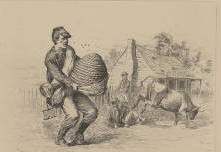
“After going about a mile further, I was put upon the mule to ride which suited me exactly. We soon sighted a house near where we found nothing save a few dried pumpkin parins’. Soon after leaving the place, we came across a pig rooting by the road side, one of the boys sent a bullet thro him and after cutting him up, hid the parts wanted in the bushes and started on and after traveling about a mile sighted another house situated about a quarter of a mile from the road. Here we found chickens, hams, bacon, Tobacco and a general assortment of provisions and were compelled; in order to carry all we wanted , to enlist the services of an old family nag [horse] we found on the place.”
Although Abram and the Kentucky soldiers spoke to the woman of the house and learned that her husband was “a loyal union man,” they decided they would confiscate food. Also, the woman had “a little babe in her arms”- so they knew they were taking food from a family who sorely needed it, despite being on the Union side. (Or so the woman said. Since homes and farms were raided by both sides, it would be smart for a family to claim they were on the side that was on their doorstep; survival was paramount.)
The soldiers knew that Hood’s forces were likely close by, so they needed to expedite their ‘shopping’ trip before they could get caught. They loaded up the mule Abram had been riding on plus took the old nag- probably the only horse the family had for plowing by that point. They started back to camp in the late afternoon, and stopped to pick up the parts of the pig they had butchered earlier. They wanted to reach camp after dark anyway, so others would not know what they had brought.
By the time Abram got to his tent, which he shared with Major Pickard, he heard the voice of Ellis, the fellow drummer he had started out with that morning. He also heard the Major giving Ellis,
“… a severe turning over for allowing me to go on with the parties we had met as they supposed me either captured or killed and just then I popped my head in the tent and then there was a time. I told the boys to keep quiet and just follow me. I then took the hungry dogs over to the 24th Ky. where my share of the proceeds of our trip were awaiting me. The boys having given me more than an equal share of what we had captured.
Well, to say the boys were delighted at the sight of all the good things would be drawing it entirely too mild, they were perfectly overjoyed and for the time being I was the hero of the camp as I divided the provisions up as far as they would reach.”
Another time, near to when he was discharged at Greensboro, North Carolina, Abram took a number of foraging expeditions with his “chum” Bruce Hardy of the 112 Illinois (whose father was an officer, also in the 112 Ill.). During one of the ‘expeditions’ they fired their guns within a few miles of camp, probably trying to hit some birds or possibly a wild hog- Abram doesn’t say why. The two boys were actually arrested by the Union pickets (guards) for that offense, as they would have feared that the enemy was nearby. (There were still southern enemies even after the Civil War officially drew to a close.) The boys were taken to General Stiles’ headquarters, and severely reprimanded before being released.
“On another occasion, we got an old mule and started out in search of something good to eat. After going about 6 miles, we … having been informed there lived a beautiful daughter of a Rebel officer, we decided to have a peep at the young lady and, hitching the mule to a little bush, we proceeded with the use of a small pocket mirror, to arrange our toilet and while thus engaged our mule, who by the way was loaded down with butter, eggs, chickens, milk and a general assortment of provisions [from their ‘shopping’ trip], pulled the bush out of the ground and before we could realize what had happened was on his way back to camp.
“We made a grand attempt to catch him but he was too much for us so we gave up the chase and also the idea of taking a peep at the beautiful maiden we had heard about. We arrived back in camp about dark where we found the mule plastered from head to tail with butter, eggs, milk, etc. and looking as though he had been run through a thrashing machine.”
The mule must have high-tailed it back to camp, smashing the provisions on his sides as he trotted through dense woods.
Abram reported that a few days later, they returned to the home of the beautiful maiden,
“… and this time saw the young lady but she hated the Yanks and would have nothing to say to us.”
The fact that the young lady would not even speak to them likely made the loss of all those good victuals doubly disappointing.
Notes, Sources, and References:
- Images from the Indiana Historical Society are low resolution for uses such as in blogs. Higher resolution images can be found on their website, with links to each image provided below.
- “On the Potomac” courtesy of Indiana Historical Society. Their description: The tintype shows members of the Twelfth Indiana Infantry eating around a campfire. The men posed for the camera, holding plates and cups. One soldier appears to be feeding another with a spoon or fork, and another holds a tin cup above a coffee pot. Identifications scratched on the back of the tintype state the photograph was made “On the Potomac, 1861.” The list of names derived from an examination of the tintype under a microscope is as follows: Lieut. Wm. W. Angel; Sargt. Jacob Kenagu [Kenagy, Private according to Terrell]; Corp Nat ?reenfield [Greenfield, Recruit according to Terrell]; Privt Geo Burwell; Jno Campbell [John S. Campbell according to Terrell]; Sanford _arns [Karns, Recruit according to Terrell]; ?; Drummer Gilly [Gilmore Hollingsworth, Musician, Company H?]; Jas St ?. via http://images.indianahistory.org/cdm/singleitem/collection/dc008/id/190/rec/1932
- “Land of Milk & Honey” by Edwin Forbes, 1876. Plate 32. Indiana Historical Society description: In 1861 Edwin Forbes was hired as a staff artist by “Frank Leslie’s Illustrated Newspaper.” He covered the Army of the Potomac from 1862-1864, and was known for his ability to draw quickly. His primary interest was in recording the everyday activity of soldiers. Plate 32, is from his publication “Life Studies of the Great Army.” The sketches are titled: Gone Off for the Yankees; A Land Flowing with Milk and Honey; A Scouting Party; An Old Campaigner. http://images.indianahistory.org/cdm/singleitem/collection/dc008/id/573/rec/1974
- “Diary of Abram F. Springsteen” transcription, completed by family members. Thank you for sharing!
Please contact us if you would like higher resolution images. Click to enlarge images.
We would love to read your thoughts and comments about this post (see form below), and thank you for your time! All comments are moderated, however, due to the high intelligence and persistence of spammers/hackers who really should be putting their smarts to use for the public good instead of spamming our little blog.
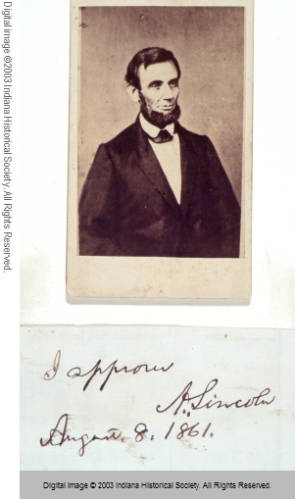

![Abraham Lincoln commemorative plaque in Indianapolis, Indiana. via Wikipedia Saves Public Art - Flickr: Lincoln Plaque by Rudolf Schwarz (1907) [Control # IAS IN000016], CC BY 2.0.](http://heritageramblings.net/wp-content/uploads/2016/02/360px-Lincoln_Plaque_by_Rudolf_Schwarz_1907_Control_IAS_IN000016.jpg)
